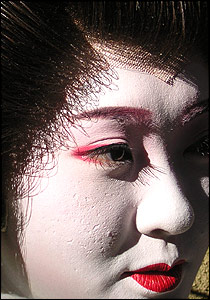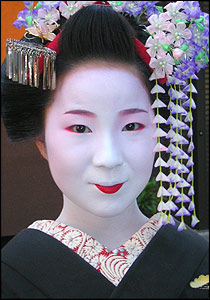Once Japan's trendsetters of fashion and taste, geisha today are both scorned as antifeminist anachronisms and revered as custodians of a treasured past
i was inspired to start this thread after reading a national geographic article:
(btw this topic, i've decided, is a fine alternative for the research i would put into japanese studies if i was attending grad school
 )
)It was in the brothels here (kyoto) and in the pleasure quarters of tokyo and osaka that geisha first appeared in the 17th century as dancers and musicians. the earliest geisha were men, but by the mid-18th century the profession was dominated by women - the tradition that remains today.
The modern geisha is the aristocrat of the huge industry that has evolved through the centuries to cater to Japanese men's sensual desires. But she is not a prostitute. If she provides sex, it is at her discretion or as part of a enduring relationship. Her business is to sell a dream - luxury, romance, and exclusivity - to the wealthiest and most powerful men in Japan. Inside the most expensive restaurants and teahouses, as men conduct delicate busines negotiations, geisha pour sake and keep the conversation flowing - at a cost of thousands of dollars.
The few women who enter the geisha world today are drawn by the romantic image or a love of traditional arts. But before World War II most geisha had no choice, they were born into the trade or were forced to join it just to survive.
In a society where a woman's place was either in the home or in the brothel, geisha carved out a separate niche, creating a community of women that became known as the 'flower and willow world.' they dressed in lavish silk kimonos and strove for perfection in makeup and courtly manners. in the 19th-century heyday they were pacesetters of fashion and popular culture, the supermodels of their time. But as Western culture overwhelmed postwar Japan, the geisha froze in time, clutching tradition as their appeal.
A geisha, which means 'a person who lives by art,' studies tea ceremony, calligraphy, and an instrument called the samisen, and trainds for dance performances that are the only public exhibition of her talents. In these extravagant shows geisha move through a series of restrained and elegant poses, displaying little exuberance.
The world of the geisha does not give up its secrets easily. The geisha's impassive white mask shows little emotion, and her strict code of silence and fierce protectiveness toward clinets conspire against revelation. Through discipline and talent, the geisha has created a life of beauty. She has made herself into the image of the perfect woman, the embodiment of Japanese culture and refinement, a living work of art. That is the source of her pride and salvation.
adapted from the book Geisha, by Jodi Cobb.
*mods feel free to move
scans
Last edited by a moderator:










